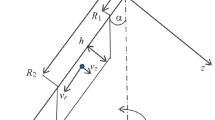Effectiveness of particle fractionation in a continuous-flow centrifuge is analyzed quantitatively on the basis of the grain-size distribution of the powder, and integral relationships with respect to computational distribution functions.


Similar content being viewed by others
References
K. T. Whitby, “Rapid general-purpose sediment-separation method for measurement of size distribution of small particles. Part 1. Apparatus and method,” Heating, Piping, and Air Condit., June, 21–27 (1955).
F. Kaizer, “The zig-zag classifier – a classifier based on a new principle,” in: Proc. Europ. Conf. on Fractionation [Russian translation], Stroiizdat, Moscow (1966), pp. 552–567.
M. D. Barskii, Powder Fractionation [in Russian], Nedra, Moscow (1980).
Z. N. Yaremko, M. N. Soltys, L. B. Fedushinskaya, et al., “Analysis of the disperse composition of suspensions based on computerized sedimentation analysis,” Zh. Prikl. Khim., 55, No. 7, 1547–1550 (1982).
P. A. Kouzov, Bases for Analysis of the Disperse Composition of Industrial Dusts and Milled Materials [in Russian], Khimiya, Leningrad (1987).
V. E. Mizonov and S. G. Ushakov, “Aerodynamic classification of finely disperse granular materials and equipment for its implementation,” Khim. Neftegaz. Mashinostr., No. 1, 7–12 (1992).
S. I. Shuvalov, “Production of finely dispersed powders in dust-preparation systems with aerodynamic classifiers,” Khim. Prom., No. 8, 499–503 (1992).
P. S. Fedotov, A. G. Zavarzina, B. Ya. Spivakov, et al., “Fractionation of heavy metals in contaminated soils and sediments using rotating coiled columns,” J. Environ. Monit., 4, No. 2, 318–344 (2002).
B. Ya. Spavakov, T. A. Maryutina, P. S. Fedotov, et al., “Separation of substances in rotating coiled columns: from microelements to micro-particles,” J. Analit. Khim., 57, No. 10, 1096–1103 (2002).
P. S. Fedotov, R. Wennrich, N. I. Stark, et al., “Continuous-flow fractionation of trace metals in environmental solids using rotating coiled columns. Some kinetic aspects and applicability of three-step BCR leaching schemes,” J. Environ. Monit., 7, No. 1, 22–28 (2005).
O. N. Katasonova, P. S. Fedotov, V. K. Karandashev, et al., “Use of rotating coiled columns for fractionation of soil particles and subsequent extraction of forms of heavy metals from slime, silty, and sandy fractions,” Zh. Analit. Khim., 60, No. 7, 765–773 (2005).
V. I. Sokolov, Centrifuging [in Russian], Khimiya, Moscow (1976).
E. V. Semenov, V. A. Karamzin, and G. D. Novikova, Methods of Analysis of Hydromechanical Processes in the Foodstuff Industry [in Russian], MGUPP, Moscow (2002).
E. V. Semenov and A. V. Karamzin, “Problem of separation of concentrated heterogeneous liquid systems,” Teor. Osn. Khim. Tekhnol., 37, No.2, 258–264 (2003).
Author information
Authors and Affiliations
Additional information
Translated from Khimicheskoe i Neftegazovoe Mashinostroenie, No. 6, pp. 3–7, June, 2012.
Rights and permissions
About this article
Cite this article
Semenov, E.V., Karamzin, A.V. Fractionation of finely dispersed particles based on the continuous flow centrifuge. Chem Petrol Eng 48, 337–344 (2012). https://doi.org/10.1007/s10556-012-9620-5
Published:
Issue Date:
DOI: https://doi.org/10.1007/s10556-012-9620-5




